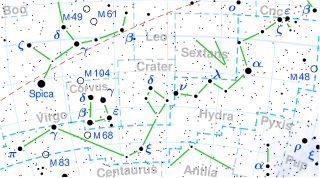| Observation data Epoch J2000 Equinox J2000 | |
|---|---|
| Constellation | Hydra |
| Right ascension | 10h 51m 37.25661s[1] |
| Declination | −21° 15′ 00.3245″[1] |
| Apparent magnitude (V) | 6.0 - 12.3[2] |
| Characteristics | |
| Spectral type | C6,3e-C7,5e(N6e)[3] |
| B−V color index | +5.43[4] |
| Variable type | SRa[3] |
| Astrometry | |
| Radial velocity (Rv) | −14.80[5] km/s |
| Proper motion (μ) | RA: −11.02 ± 1.14[1] mas/yr Dec.: 2.29 ± 1.16[1] mas/yr |
| Parallax (π) | 1.44 ± 1.41 mas[1] |
| Distance | approx. 2,000 ly (approx. 700 pc) |
| Absolute magnitude (MV) | −3.5 to +1.8[6] |
| Orbit[7] | |
| Period (P) | 17.5 yr |
| Eccentricity (e) | ~0.0 |
| Details | |
| A | |
| Mass | 1.0[8] M☉ |
| Radius | 420[9]–430[10] R☉ |
| Luminosity | 7,850[8] L☉ |
| Surface gravity (log g) | −0.5[8] cgs |
| Temperature | 2,650[8] K |
| Rotational velocity (v sin i) | 11 - 14[8] km/s |
| B | |
| Mass | <1[10] M☉ |
| Other designations | |
| Database references | |
| SIMBAD | data |
V Hydrae (V Hya) is a carbon star in the constellation Hydra. To date perhaps uniquely in our galaxy it has plasma ejections/eruptions on a grand scale that could be caused by its near, unseen companion.
- ^ a b c d e Van Leeuwen, F. (2007). "Validation of the new Hipparcos reduction". Astronomy and Astrophysics. 474 (2): 653–664. arXiv:0708.1752. Bibcode:2007A&A...474..653V. doi:10.1051/0004-6361:20078357. S2CID 18759600.
- ^ Watson, Christopher (4 January 2010). "V Hydrae". The International Variable Star Index. American Association of Variable Star Observers. Retrieved 2016-10-12.
- ^ a b Samus, N. N.; Durlevich, O. V.; et al. (2009). "VizieR Online Data Catalog: General Catalogue of Variable Stars (Samus+ 2007-2013)". VizieR On-line Data Catalog: B/GCVS. Originally Published in: 2009yCat....102025S. 1. Bibcode:2009yCat....102025S.
- ^ Ducati, J. R. (2002). "VizieR Online Data Catalog: Catalogue of Stellar Photometry in Johnson's 11-color system". CDS/ADC Collection of Electronic Catalogues. 2237. Bibcode:2002yCat.2237....0D.
- ^ Gontcharov, G. A. (2006). "Pulkovo Compilation of Radial Velocities for 35 495 Hipparcos stars in a common system". Astronomy Letters. 32 (11): 759–771. arXiv:1606.08053. Bibcode:2006AstL...32..759G. doi:10.1134/S1063773706110065. S2CID 119231169.
- ^ Gordon, Courtney P. (1968). "The Absolute Magnitudes of Carbon Stars". Publications of the Astronomical Society of the Pacific. 80 (476): 597. Bibcode:1968PASP...80..597G. doi:10.1086/128694.
- ^ Planquart, L.; Jorissen, A.; et al. (2024). "A dynamic view of V Hydrae. Monitoring of a spectroscopic-binary AGB star with an alkaline jet". Astronomy & Astrophysics. 682: A143. arXiv:2405.07820. Bibcode:2024A&A...682A.143P. doi:10.1051/0004-6361/202347947.
- ^ a b c d e Zhao-Geisler, R.; Quirrenbach, A.; Köhler, R.; Lopez, B. (2012). "Dust and molecular shells in asymptotic giant branch stars". Astronomy & Astrophysics. 545: A56. arXiv:1207.3767. Bibcode:2012A&A...545A..56Z. doi:10.1051/0004-6361/201118150. S2CID 53992211.
- ^ Luttermoser, Donald G.; Brown, Alexander (1992). "A VLA 3.6 centimeter survey of N-type carbon stars". Astrophysical Journal. 384: 634. Bibcode:1992ApJ...384..634L. doi:10.1086/170905.
- ^ a b Sahai, R.; Scibelli, S.; Morris, M. R. (2016). "High-speed Bullet Ejections during the AGB-to-Planetary Nebula Transition: HST Observations of the Carbon Star, V Hydrae". The Astrophysical Journal. 827 (2): 92. arXiv:1605.06728. Bibcode:2016ApJ...827...92S. doi:10.3847/0004-637X/827/2/92. S2CID 119209118.
